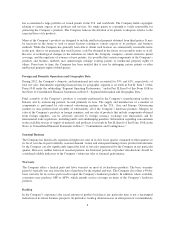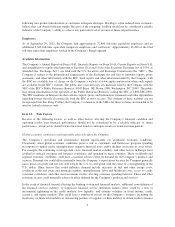Apple 2012 Annual Report Download - page 17
Download and view the complete annual report
Please find page 17 of the 2012 Apple annual report below. You can navigate through the pages in the report by either clicking on the pages listed below, or by using the keyword search tool below to find specific information within the annual report.regulations or in their interpretation could individually or in the aggregate make the Company’s products and
services less attractive to the Company’s customers, delay the introduction of new products in one or more
regions, or cause the Company to change or limit its business practices. The Company has implemented policies
and procedures designed to ensure compliance with these laws and regulations, but there can be no assurance that
the Company’s employees, contractors, or agents will not violate such laws and regulations or the Company’s
policies.
The Company’s success depends largely on the continued service and availability of key personnel.
Much of the Company’s future success depends on the continued availability and service of key personnel,
including its Chief Executive Officer, executive team and other highly skilled employees. Experienced personnel
in the technology industry are in high demand and competition for their talents is intense, especially in the
Silicon Valley, where most of the Company’s key personnel are located.
The Company’s business may be impacted by political events, war, terrorism, public health issues, natural
disasters and other circumstances.
War, terrorism, geopolitical uncertainties, public health issues, and other business interruptions have caused and
could cause damage or disruption to international commerce and the global economy, and thus could have a
material adverse effect on the Company, its suppliers, logistics providers, manufacturing vendors and customers,
including channel partners. The Company’s business operations are subject to interruption by natural disasters,
fire, power shortages, nuclear power plant accidents, terrorist attacks, and other hostile acts, labor disputes,
public health issues, and other events beyond its control. Such events could decrease demand for the Company’s
products, make it difficult or impossible for the Company to make and deliver products to its customers,
including channel partners, or to receive components from its suppliers, and create delays and inefficiencies in
the Company’s supply chain. Should major public health issues, including pandemics, arise, the Company could
be adversely affected by more stringent employee travel restrictions, additional limitations in freight services,
governmental actions limiting the movement of products between regions, delays in production ramps of new
products, and disruptions in the operations of the Company’s manufacturing vendors and component suppliers.
The majority of the Company’s research and development activities, its corporate headquarters, information
technology systems, and other critical business operations, including certain component suppliers and
manufacturing vendors, are in locations that could be affected by natural disasters. In the event of a natural
disaster, the Company could incur significant losses, require substantial recovery time and experience significant
expenditures in order to resume operations.
The Company’s business and reputation may be impacted by information technology system failures or network
disruptions.
The Company may be subject to information technology system failures and network disruptions. These may be
caused by natural disasters, accidents, power disruptions, telecommunications failures, acts of terrorism or war,
computer viruses, physical or electronic break-ins, or similar events or disruptions. System redundancy may be
ineffective or inadequate, and the Company’s disaster recovery planning may not be sufficient for all
eventualities. Such failures or disruptions could prevent access to the Company’s online stores and services,
preclude retail store transactions, compromise Company or customer data, and result in delayed or cancelled
orders. System failures and disruptions could also impede the manufacturing and shipping of products, delivery
of online services, transactions processing and financial reporting.
The Company may be subject to breaches of its information technology systems, which could damage business
partner and customer relationships, curtail or otherwise adversely impact access to online stores and services,
and could subject the Company to significant reputational, financial, legal, and operational consequences.
The Company’s business requires it to use and store customer, employee, and business partner personally
identifiable information (“PII”). This may include names, addresses, phone numbers, email addresses, contact
16
























